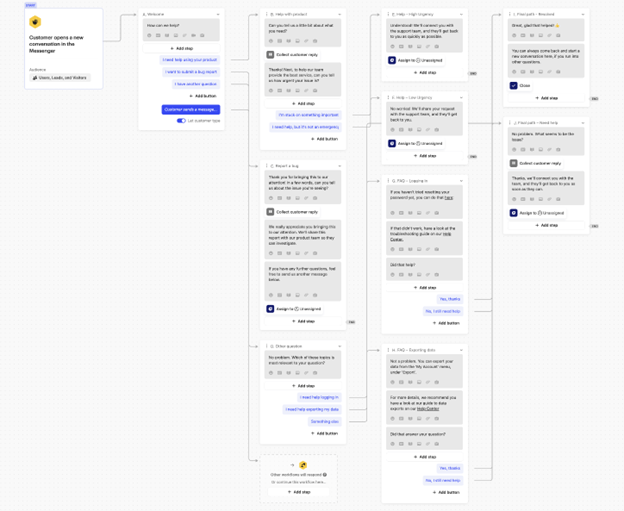-
Services
-
Locations
- Philippines
- United States
- Colombia
- Eastern Europe
Locations -
Industries
-
Resources
- E-Books
- Blog
- Case Studies
Resources - About Us
- Careers
Customer Support for Live Chat
A comprehensive guide to learn why live chat should become a foundational tool in your customer support team’s daily routine

The Power of Live Chat
When people reach out to your team, they expect quick responses and will easily switch to a competitor if you fail to deliver.
That’s where live chat comes in as one of the key support channels today.
Recent research conducted by Kayako reveals that over 50% of consumers are more likely to remain loyal to a company that offers live chat support. To stay ahead of the competition, you need to align with customer expectations by investing in the live chat function on your website.
In this e-book, we’ll explore the benefits of offering live chat support, dive into the implementation process, and outline the key performance indicators (KPIs) to gauge the effectiveness of your live chat service.
Benefits of Live Chat
Live chats have become a customer favorite
Boasting an impressive average satisfaction rating of 86% – surpassing that of all other support channels.
If done well, a live chat service has the power to boost customer loyalty and drive significant benefits for your business.
Let’s go over the main advantages that live chat offers to both your customers and your business, making it a worthwhile investment.
Benefits of Live Chat for Customers
Live chat is faster than email, and often more convenient than phone support.
Customers no longer have the patience for slow response times and won’t hesitate to seek alternatives if their inquiries are not promptly addressed. While email support is still common, when questions go unanswered for hours or days, it doesn’t align with the growing need for immediacy. Live chat conversations, on the other hand, are typically resolved within minutes.
Unlike traditional email support, where a customer’s question can require lengthy emails to be fully resolved, live chat allows for immediate back-and-forth communication that speeds up the problem-solving process.
Live chat has the added benefit of enabling customers to share screenshots, photos, and screen recordings, making it far easier for support agents to resolve issues efficiently.
Phone support also offers the option of immediate resolution and the ability to have a back-and-forth conversation. But you can’t multitask while you’re on the phone with customer support. By contrast, you can initiate a chat on your phone or desktop browser while going about your day.
Benefits of Live Chat for Businesses
Of course, it would be hard to justify the live chat implementation if it only enhanced the customer experience without delivering any business benefits. Fortunately, a live chat service does indeed offer significant advantages for businesses as well, including:
Live chat agents are able to juggle up to six different chats simultaneously, depending on the complexity of the issues involved. We don’t recommend this level of concurrency, as it can reduce quality and lead to agent burnout. But even a concurrency of 2 or 3 chats at a time makes this channel significantly more efficient than phone support. This allows for a more efficient allocation of resources since you don’t have to staff a live chat team as heavily as call center teams that can only handle one call at a time.
Recent advancements in AI have unlocked a range of opportunities for automating live chat operations without compromising the customer experience. AI bots can offer relevant resources while customers wait for human assistance; collect key details before passing tickets on to the support team; and resolve some simpler tickets without human intervention at all.
Live chat encourages natural conversations, replacing detached and delayed email communication and making it easier to build rapport with customers. When 71% of customers seek a natural conversational experience, live chat offers exactly that – similar to a phone call but without demanding the hassle of an actual phone call.
Various studies underscore that customers are more likely to make a purchase when live chat support is available. For instance, Goinflow reported a notable 6% boost in revenue following the live chat implementation. Live chat empowers support teams to drive additional sales by, for example, recommending a complementary product or outlining the benefits of upgrading to a higher plan.
Live Chat Implementation
Once you’ve secured buy-in for integrating a customer support chat service on your website, the next phase is rolling it out.
To get it right, you’ll need to staff the live chat with an adequate number of agents and provide comprehensive training for rapid response times.
Below are the essential steps for a smooth live chat implementation to help you get started.
Live chat service around the clock isn’t always necessary. You could start with one shift and expand from there.
The required headcount will depend on the chat volume, resolution times, coverage requirements, and factors specific to your organization. For example, let’s say 12 to 1 is the busiest hour of the day for your support team, and you want to respond in less than a minute. You’ll need to staff enough agents to meet that volume, even if that means you’re overstaffed other hours of the day.
If you don’t have your own workforce management team or software, you could explore tools such as the Erlang calculator, which allows you to calculate the optimal staffing based on your volume, handle time, and desired service level. Our article on how to build a call center staffing model will show you how to build a model that can also account for volume patterns.
Smaller companies may want to start by turning on chat during peak times only. That allows you to test your staffing and systems and ensure everything’s running
smoothly before you expand coverage.
Live chat demands experienced and adaptable support professionals.
Since it’s such an immediacy-driven environment, any support agent who spearheads a live chat service will need to be able to transition from one task to another seamlessly.
For example, at Peak Support, we typically have our agents master email service before moving them to live chat. While an email support agent can ask for help if they’re unsure of an answer, the immediacy of live chat makes that impossible. This is why live chat agents must undergo rigorous training and be able to navigate the faster-paced nature of real-time conversations effectively.
Equipping your agents with quick macros for greetings, handoffs, escalations and other common live chat scenarios can go a long way in boosting their response times and saving mental energy by erasing the need for typing the same responses again and again.
Gartner predicts that by 2027, chatbots will become the primary customer service channel for a quarter of all businesses.
Chatbots aren’t all powered by AI. You can also build a rules-based chatbot that responds based on the instructions you provide. Here’s an example of a rules-based chatbot flow:

An example of Intercom’s Chatbot Builder decision tree
If most of your routine queries can be solved with a concise, one-paragraph article, rule-based automation can be great for guiding customers down a decision tree and prompting them to select the most relevant option at each step. Too many options can overwhelm users, while too few may lack the necessary granularity. Typically, presenting 3-6 options at each step strikes the right balance
Another important item for a customer care chat experience is offering an easy opt-out. There’s nothing quite as annoying as having to rephrase the same question three or four times before finally getting connected with a real person. That’s why it’s essential to offer customers a straightforward way to transition to human assistance if needed. That doesn’t mean a way to transfer to human support needs to be the first thing you offer your customers — but don’t make them hunt to find it, either.
Smart automations and chatbot flows can have a massive impact on your servicelive chat success. When we optimized the website live chat experience for a client in the pet industry — including revising their chatbot menu, making the “chat with a human” option appear later, and optimizing chatbot flows — they saw a 75% reduction in human chat conversations, while maintaining a 97% CSAT.
AI assistants are basically supercharged chatbots.
Customers ask questions, and the bot can track down the information During non-business hours, directing website visitors to your self-service knowledge base empowers them to find solutions independently. For a better experience, set up a conversational AI bot to alleviate the burden on customers – they can simply ask questions and have the bot track down the information they require.
The AI model setup may not be as straightforward as some providers claim, so let’s review the key steps to ensure that you achieve the best outcomes with your AI tool.
For the AI answers to align with your brand’s tone of voice and offer a consistent customer experience, assign your AI model with attributes, such as “professional”, “friendly” or “casual” and experiment with the responses until you land on the desired tone. The persona should work for different types of queries from feature requests to messages about product outages. While creating an AI model with a dry British sense of humor may seem funny, it can backfire if it insults your customers.
Use historical chat conversations and solved support tickets for the AI to learn from real-world interactions and comprehend user intents better.
Put your AI model through a stress test with a large body of potential questions, including some that have nothing to do with your product and others that are very difficult, and attempt to overwhelm or break the AI to identify weak spots in its behavior. The purpose of the test is to ensure that your AI model can navigate any situation appropriately.
Running AI-handled conversations through the same quality assurance scorecard as your human agents is also a great way to ensure consistent performance and identify opportunities for improvement. In addition, you’ll want to measure other KPIs to ensure your bot is performing (see below).
Training conversational AI can be a full-time job for the first few weeks or months. But even once it’s good enough to launch, you’ll still need to maintain and train your bot in an ongoing manner – forever. That might feel like bad news, but really, all this means is that you need to think of your AI assistant the same way you’d think of a human agent: always growing, always improving, and never finished.
Key Performance
Indicators to Track
With so many options available, setting the right targets and determining key metrics to track can be daunting.
To simplify this task, here are the main live chat KPIs that you should monitor for both your support team and AI automations.
Chat Metrics for Human Agents
Live chat is popular because it’s “live,” and customers expect it to live up to its name, making the response time a critical KPI to keep tabs on. While the average wait time for live chat hovers around a few minutes, a better target to aim for is under 2 minutes. Zendesk suggests that customers anticipate a reply within 1 minute and our research on KPI benchmarks shows that the best companies respond within 15 seconds, so the faster you can provide a response, the better.
While customers don’t want to wait for the initial response, it’s not the only thing that matters. Chat handle time is equally significant. The standard benchmark across industries is approximately 10 minutes. However, the optimal handle time target will look different for each company, based on the complexity of your product and your customers’ inquiries.
Every time you miss a chat, you’re missing out on a chance to help a customer or make a sale. Prompt and helpful responses are crucial for building customer trust and preventing those leads from taking their business elsewhere. On average companies miss 24% of chats, but with effective workforce management and the right tools, you can do far better than that.
While speed is important, customers also value efficiency and don’t want to send twenty messages to get a simple question answered. The FCR rate indicates how well your team can resolve customer requests in a single interaction, and an average FCR benchmark is about 72%. Strong first contact resolution reflects your team’s efficiency, product knowledge, and commitment to making things easy for customers.
Always give your customers a survey to measure how satisfied they are with the interaction.
Chat Metrics for Bots
Depending on your AI model’s configuration, your bot may skip inquiries that don’t have a direct answer within its resources. Monitoring the percentage of conversations where the bot attempts to provide at least one answer allows you to assess the effectiveness of the resources and promptly update them when this rate goes down.
Lengthy chatbot flows can be exhausting and cause customers to disengage before reaching your support team if you require too many steps to solve their query. Monitoring drop-off rates helps evaluate the effectiveness of the chatbot’s dialogue flow and identifies any issues causing friction while customers engage with your bot.
Also referred to as the deflection rate, the resolution rate indicates the proportion of users who did not require human assistance after interacting with your bot. Assuming customers exit chat because they got relevant answers, the resolution rate serves as a perfect measure of automation effectiveness in your live chat processes. The benchmark for resolution rate typically hovers around 50% but we’ve achieved resolution rates as high as 96%.
Implementing any changes should yield a measurable return on investment (ROI). The cost-saved metric helps understand your automation’s ROI based on the average support conversation cost and the number of tickets automatically handled by the bot. This amount would have been spent on human labor, but with your bot taking care of frequently asked questions, your human agents can dedicate their time to solving more complex issues.
Last but not least is customer satisfaction. Tracking CSAT ratings separately for conversations with and without bot involvement will help you grasp the impact of AI automation on customer experience and assess whether the time saved through AI implementation aligns with improved customer satisfaction.
Setting Your Team
Up for Success
Here are some final tips for a successful live chat implementation to navigate potential pitfalls and deliver exceptional customer experiences.
No matter how fast you’re able to turn chats around, communicate your response time upfront to manage customer expectations effectively. The “We typically reply within X minutes” can go a long way towards a positive live chat experience, especially when immediate responses are not feasible for your team yet.
A comprehensive and user-friendly knowledge base is crucial for creating a good bot, and for providing agents with easy access to all the necessary information while handling chats. Well-organized docs reduce the time spent searching for answers, allowing agents to focus on resolving customer issues efficiently.
Running through common live chat scenarios from a customer standpoint helps identify gaps and flaws in your live chat experience. Perhaps the chatbot makes it too difficult to get human assistance, or your live chat button doesn’t pop up on specific pages. Regularly reviewing the flow allows for continuous improvements, ensuring the best possible experience for your website visitors.
Recognizing high burnout rates in contact centers, agent well-being has become a focus for customer service leaders. Burnout can lead to low performance and slow response times, even with a well-trained team. Cultivating a positive and supportive work environment and prioritizing agent experience in your live chat workflow helps combat burnout and fosters better long-term outcomes.
Ready to outsource?
Get the latest updates on how to effectively scale your customer service teams!

For a deep dive on KPIs, check out our e-book, A Complete Guide to Key Performance Indicators for Customer Service. It contains benchmark data so you can see how your company stacks up against others.
For a deep dive on KPIs, check out our e-book, A Complete Guide to Key Performance Indicators for Customer Service. It contains benchmark data so you can see how your company stacks up against others.

Chatting with the Future
The role of website live chats in customer service has never been more crucial. It allows you to connect with customers and address their needs right away and helps streamline support operations, drive sales, and boost customer loyalty.
Investing in a well-designed live chat system and staffing it with proficient customer support agents can transform casual website visitors into loyal customers by connecting with them at the right moment and nurturing them toward a purchase. According to recent research by Kayako, implementing live chat service has positively impacted sales, revenue, and customer loyalty for 79% of businesses.
Regardless of your industry or company goals, integrating live chat into your customer service toolkit has no downsides. Done correctly, it can significantly enhance the customer experience, improve business outcomes, and cultivate brand advocates among your website visitors.
Ready to chat with us?
We’ve helped dozens of innovative companies launch and scale their customer service teams. Whatever you need to grow your business, our flexible offerings can fit. Let’s chat about how outsourcing can unlock new levels of growth for your business.

